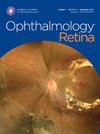Disparities in United States Retinoblastoma Presentation, Management, and Local Recurrence in the National Cancer Database, 2004–2016
IF 5.7
Q1 OPHTHALMOLOGY
引用次数: 0
Abstract
Purpose
To investigate patient-level differences in retinoblastoma presentation, treatments, and outcomes within the United States (US).
Design
Retrospective registry-based analysis.
Participants
One thousand, four hundred and four retinoblastoma cases in the National Cancer Database, 2004–2016, a US-based cancer registry.
Methods
Patient characteristics and treatments were investigated over time. Primary treatment was classified as enucleation, local tumor destruction, chemotherapy, and radiation. Multivariable logistic regression models evaluated extraocular disease at presentation, treatment, and local recurrence after primary globe-sparing therapy.
Main Outcome Measures
Odds ratios (ORs) for extraocular disease at presentation; primary treatment modality; local recurrence after primary globe-sparing therapy.
Results
Extraocular disease affected 13% of patients at presentation (N = 178). All-cause mortality among the entire cohort was 3.1% (n = 44) at last follow-up Those who were non-White, who were uninsured or had government-funded insurance, or with nonmetropolitan residence had significantly greater odds of extraocular disease (OR 2.21–3.64 for non-White vs. White non-Hispanic patients, OR 2.05–2.95 for uninsured or Medicaid/Medicare/government-funded vs. private/commercial insurance, and OR 1.80 for nonmetropolitan vs. metropolitan residence). Between 2004 and 2016, utilization of chemotherapy (55%–73%) and local tumor destruction (17%–27%) increased. Enucleations remained overrepresented among Hispanic patients (63% received enucleation in 2016, vs. 35% non-Hispanic patients; OR = 1.83 (95% confidence interval [CI] 1.22–2.75) for enucleation among Hispanic vs. White, non-Hispanic patients). Patients with Medicaid/Medicare/government insurance and nonmetropolitan residents also had higher odds of enucleation, and nonmetropolitan patients had higher odds of local recurrence after primary globe-sparing therapy.
Conclusions
Despite an overall decline in enucleation and increase in globe-sparing therapy between 2004 and 2016, Hispanic, Medicaid/Medicare/government-insured, and nonmetropolitan patients continued to have higher odds of extraocular disease at presentation and higher odds of undergoing enucleation as primary therapy. This suggests limitations in access to care and that shifts toward globe-sparing treatment (chemotherapy and local tumor destruction) did not occur equally across all patient groups. Further investigations into these disparities are warranted.
Financial Disclosure(s)
Proprietary or commercial disclosure may be found in the Footnotes and Disclosures at the end of this article.
2004-2016年全国癌症数据库中美国视网膜母细胞瘤发病、管理和局部复发的差异。
目的:调查美国视网膜母细胞瘤患者在发病、治疗和预后方面的差异:设计:基于登记的回顾性分析:2004-2016年美国国家癌症数据库(National Cancer Database)中的1404例视网膜母细胞瘤病例:方法:调查不同时期的患者特征和治疗方法。主要治疗方法分为去核、局部肿瘤切除、化疗和/或放疗。多变量逻辑回归模型评估了患者发病时的眼外疾病、治疗情况以及初次保球治疗后的局部复发情况:主要结果测量指标:发病时眼外疾病的比值比;主要治疗方式;主要保球治疗后的局部复发:结果:13%的患者发病时患有眼外疾病(178例)。非白人、无保险或有政府资助的保险或居住在非大都市的患者患眼外疾病的几率明显更高(非白人与非西班牙裔白人患者的OR值为2.21-3.64,无保险或医疗补助/医保/政府资助与私人/商业保险的OR值为2.05-2.95,居住在非大都市与居住在大都市的OR值为1.80)。2004-2016 年间,化疗(55% 至 73%)和局部肿瘤切除(17% 至 27%)的使用率有所上升。西班牙裔患者接受去核手术的比例仍然偏高(2016年,63%的西班牙裔患者接受了去核手术,而非西班牙裔患者为35%;西班牙裔患者与白人、非西班牙裔患者相比,去核手术的OR=1.83,(95% CI为1.22-2.75))。医疗补助/医疗保险/政府保险患者和非大城市居住的患者接受去核手术的几率也较高,非大城市患者接受初级保球治疗后局部复发的几率也较高:尽管2004-2016年间去核手术总体上有所减少,保球疗法有所增加,但西班牙裔、医疗补助/医疗保险/政府保险和非大城市患者在就诊时患有眼外疾病的几率仍然较高,接受去核手术作为主要疗法的几率也较高。这表明在获得治疗方面存在局限性,而且向保全眼球治疗(化疗和局部肿瘤切除)的转变并没有在所有患者群体中平等发生。有必要进一步调查这些差异。
本文章由计算机程序翻译,如有差异,请以英文原文为准。
求助全文
约1分钟内获得全文
求助全文

 求助内容:
求助内容: 应助结果提醒方式:
应助结果提醒方式:


